Art Bergmann Plays Air Guitar In My Head
Saturday, March 28, 2009
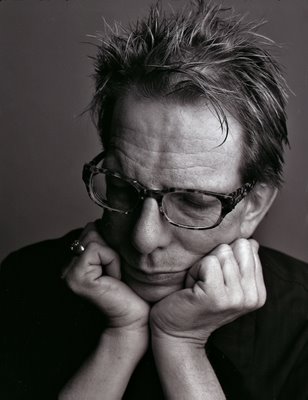 As the amateur that I am, I can assert without any compunction that the best rock guitarist I have ever heard is Art Bergmann. His unusual voice (like listening to someone talk on a faulty cassette tape recorder with wow) is secondary in my appreciation of the man. On the other hand there is his music. There are his lyrics. An Art Bergmann performance without his guitar playing is an Art Bergmann performance diminished by more than half. While Bergmann has little respect for such mundane objects as microphones (he demolished one in this Thursday’s performance at Richards on Richards), perhaps he vented his anger at not being physically capable of playing the guitar on the microphone and its uncooperative stand. As I watched Tony Balony (a.k.a. Anthony Walker) play his guitar most competently and even with some touch of virtuosity I noticed how he stood and how he hammed it up. Bergmann always treated his instrument with respect even if he banged it here and there. The guitar was nothing to make fun of. With a guitar in hand Bergmann dominated the stage. With Jim Bescott on bass and Bary Taylor on drums the K-Tels/Young Canadians of 1979/1980 were the finest rock band I ever heard. Later Art Bergmann bands were tolerable and sometimes even wonderful as long as Bergmann sang and played that guitar. Thursday Night I was right under Bergmann’s microphone leaning on a monitor. Few are aware that paradoxically the closer you are to the middle of a very loud rock band the less loud it is. Next to me was former Los Popularos bassist Tony Bardach and his lovely trophy daughter Alexa with painted red lips and a look reminiscent of Moev’s Madeleine Morris. Behind me was Ingrid (an old flame of Bud Luxford) and Solei (Soledad) an early old flame of Bergmann’s. I felt much at home. 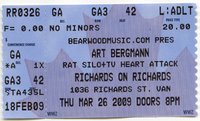 I am keenly aware that there was no way that Bergmann could have played his guitar. He managed, more or less, to sing. Halfway through the performance he either decided to ignore the intense pain of his back and of his knees because he suddenly stood almost straight. In my studio, the day before, he had fallen face first when he leaned too far forward in my posing chair. While he insisted that everything was fine I am sure that was not the case. Bergmann walked around the Richards on Richards stage without falling in spite of not wearing the glasses he almost stepped on. Few of the crowd would have known that Bergmann was pretty well blind without glasses back in 1980! I watched young girls around me with constant smiles in their faces dance while Bergmann sang Our Little Secret. “What a lovely tune. What a lovely pop song this is,” they must have thought as I pondered on the fact that the song in question was about incest. As I drove home I experienced the instant satisfaction of listening to Lost Art Bergmann, the previously unreleased CD mixed by Bob Rock. It’s smooth, it’s lively, it’s clear; the tunes sound like pop songs. This is Bergmann at his best pop-song-best. Can that be possible? Am I getting so old that it sounds like stuff I could play to my granddaughters? 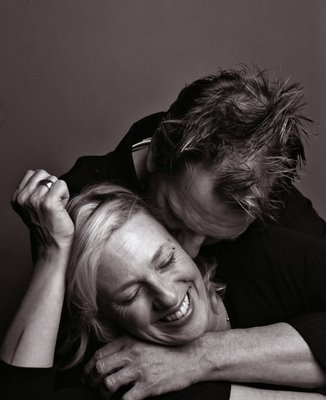 But then there are the lyrics. And there is that guitar. Art Bergmann did not play his guitar on Thursday. But his guitar was in my head and that was more than enough. Outside, after the concert, I ran into Gord Nichol who played with Bergmann in Los Popularos. "Alex did you ever think in a million years that this would happen?" "No," I answered. He did not have to say what we both thought. This would never happen again as we smiled at our mutual good fortune of having been there.
Friday, March 27, 2009
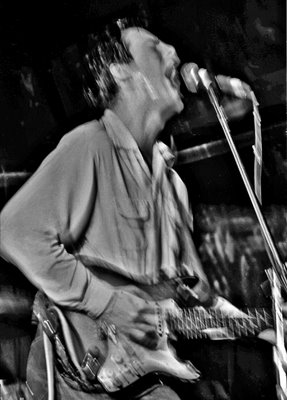 From the late 70s until the beginning of the 90s I worked with Les Wiseman in contributing photographs to his Vancouver Magazine rock column In One Ear. This was the era of the all powerful record label rep and we had to deal with them to get access to the likes of Joan Jet and The Police. While I photographed many concerts the bulk of the pictures that ended up with In One Ear where either back stage photographs or posed sessions with the musicians in their hotel rooms, usually right after Wisman's interview. In those years I wrestled with the idea of taking original concert photographs. It soon became evident that no matter how much I tried my pictures looked liked everybody else's. If the other person did not have front stage access and I did, then my pictures were "good" only because they were so. It was in the mid 80s that Wiseman and I traveled to New York City to try to get magazine work. I wrote about that here. We both called Rolling Stone for interviews. I talked to the art director. She asked me on the phone, "Do you have concert photographs?" I immediately answered, "No. I have back stage and hotel room photos." On the strength of my answer she gave me a coveted interview that went for naught as our only rocker of fame at the time was Red Rider. Rolling Stone was not interested in Red Rider. At Esquire Adam Moss told Wiseman, "You have a great portfolio. In Canada you have a prime minister called Joe Clark. We are not interested in him." And that was the end of our hopes for work in New York. I never forgot my lesson about concert photographs and the difficulty of making them original. Through the years I have developed a style which is dependant on a one-on-one relationship in my studio with my subject. I like to be very close so I never used long focus lenses. This relationship is impossible at a concert. Last night at the concert featuring Art Bergmann at Richards on Richards several persons either shouted into my ear (it was loud last night), "Where is your camera?" or they gesticulated with their hands to imitate the firing of a camera. I could not really explain and didn't. 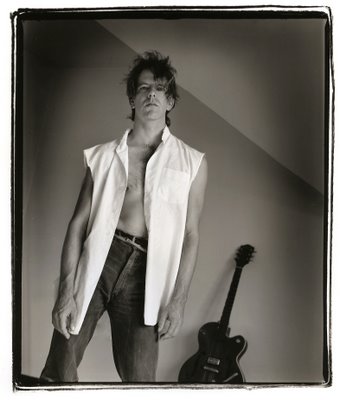 What you see above is a photograph of Art Bergmann, sometime in the 80s at Gary Taylor's Rock Room. I remember that the bass player was the Modernettes' Mary Jo Kopechne. I don't remember the circumstances as to why she was the bass player. In those days my attempt to rock concert originality was to use an extremely slow shutter and a flash at the same time. I believe that the noise and the excitement of a concert rarely is transfered on to a photographic image. The photo on the right is of Art Bergmann in the late 80s taken in my style.
Lola Maclaughlin Almost Made Me A Dance Photographer
Thursday, March 26, 2009
 March 1, 1952, March 6, 2009
While reading today’s Vancouver Sun entertainment section Life I noticed what had to be a typo:
Discover Dance: Lola Dance
Scotiabank Dance Centre
Described as the late choreographer Lola MacLaughlin’s most stunning dance creation, Provincial Essays is…
“The late choreographer Lola Maclaughlin,”I said to myself. "That cannot be true.I never read about it." Since I never watch local TV news and my only source of local news is the Vancouver Sun or CBC Radio, when I am in the car, I had somehow missed this important tragedy in Vancouver's dance community.

A former Vancouver Sun dance critic confirmed that the Vancouver Sun had run a paid obituary when Lola MacLaughlin died March 6 of ovarian cancer. A Vancouver Sun staffer confirmed this on the phone and had no explanation for the oversight. I checked the web and noticed that the Province ran a large obituary as did the Globe & Mail. Max Wyman wrote and obituary after the fact.
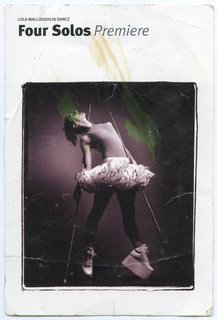
In 1998 I received a call from Lola Maclaughlin asking me if I could take the promotional pictures for her new dance, Four Solos. I explained to Maclaughlin that I knew how to take portraits but did not have a clue how to shoot dance. She was persuasive on the phone, "Alex I know you can do this and besides I will be there to help you." Four Solos involved four different cities in Europe. The dancers were Fiona MacDonald (Venice), Susan Elliott, Jennifer Murray and Hope Terry.
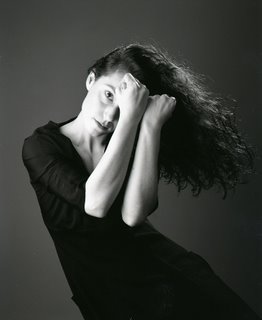
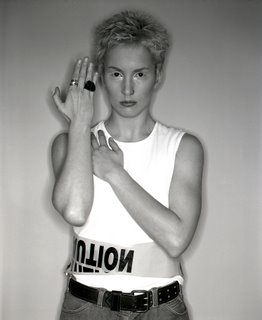
 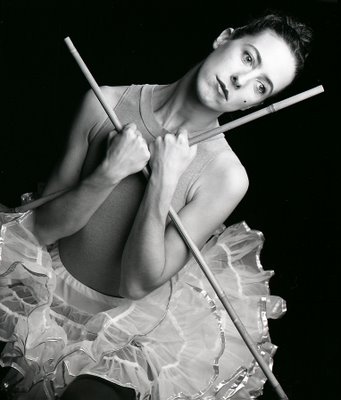
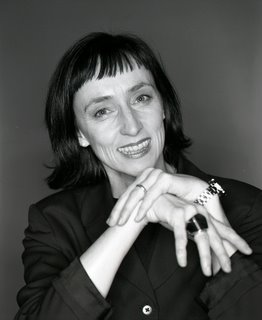 In my files I found one promo piece card, with Fiona Macdonald on it, that seemed to have been stepped on! It's all I have besides all those fine negatives that Lola Maclaughlin somehow knew I had in me to take. The picture of Maclaughlin with the male dancer is with Cornelius Fischer-Credo. I will miss Lola Maclaughlin and I feel ashamed. I am ashamed that our city newspaper missed giving her the tribute that she so deserved for her contribution to the cultural wellbeing of our existence.
Addendum
I miss Lola so much. Thank you for your thoughts and words on the passing of my dear friend. I hope you can join us on April 6th at the Dance Centre, a celebration of her life 4:30-6:30pm.
The other dancers in the show were: Andrea Gunnlaugson: Vienna (replacing Fiona Macdonald,) Jen Murray as Berlin, myself as Brussels and Hope Terry as Venice.
all my best,
Susan
The Man Behind The Trifocals Pays Me A Social Call
Wednesday, March 25, 2009
 Dear friend now in the dusty clockless hours of the town when the streets lie black and steaming in the wake of the watertrucks and now when the drunks and the homeless have washed up in the lee of the walls in alleys or abandoned lots and cats go forth highshouldered and lean in the grim perimeters about, now in these sootblacked brick or cobbled corridors where the lightwire shadows make a gothic harp of cellar doors no soul shall walk save you. Dear friend now in the dusty clockless hours of the town when the streets lie black and steaming in the wake of the watertrucks and now when the drunks and the homeless have washed up in the lee of the walls in alleys or abandoned lots and cats go forth highshouldered and lean in the grim perimeters about, now in these sootblacked brick or cobbled corridors where the lightwire shadows make a gothic harp of cellar doors no soul shall walk save you. Sutree, Cormac McCarthy, 1979 I reminded the man behind the trifocals facing my camera, that he had borrowed and read and, returned my entire Cormac McCarthy collection. The man behind the trifocals acknowledged this. "My fave," I told him, "was Sutree." "Mine, too," said the man behind the trifocals. It was sometime shortly after the Berlin wall fell in 1989 when science fiction writer William Gibson was in a hotel in what had been West Berlin. He was going on a tour of East Berlin but could not get himself out of the room because of a book. Gibson was reading a most remarkable novel. He postponed his tour so he could finish it. When Gibson returned to Vancouver he gave me a call, "Alex I read this book in Berlin and...it's called Sutree. Read the first two and a half page preface. It is beautiful." Gibson was right. I am not all that sure that the man behind the trifocals will be able to manage a guitar tomorrow night. He is in too much pain. Perhaps the excitement of being on stage with an electric guitar will give him the impetus to play and forget the pain. He might sing. The voice is still unmistakable, the warmth is there. The thick trifocals cannot mitigate the penetrating intelligence. The man behind the trifocals has made me a social call. Can I be so lucky? Perhaps some day when he is not feeling too well (worse than he was feeling today) I will suggest: Maybe later
we'll get together
learn how to relax
maybe later
we'll get together
and have a relapse.The Hospital Song, Art Bergmann I think that would be lot's of fun.
Tuesday, March 24, 2009
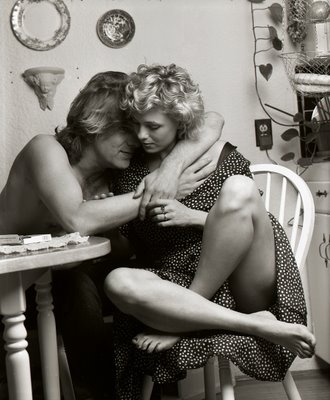 In preparation to taking pictures of Art Bergman and his wife Sheri in my studio tomorrow morning I have been looking at my extremely thick files on Bergmann. In an envelope marked Art Bergmann at home (no date) I found these. There are also pictures of Art and Sheri in bed that are as beautiful. I thought to myself, "What can I possibly write about them?" I thought of one of my most favourite jazz records of all time, Gerry Mulligan's 1959 What Is There To Say? (with Art Farmer on trumpet, Bill Crow on bass and Dave Bailey on drums) The beautiful song that starts this record, What is there to say? is credited to Jarburg, Duke and it was recorded in New York City January 15, 1959. I cannot possibly write anything about this photograph except to say how lucky I was. Gerry Mulligan's liner notes: 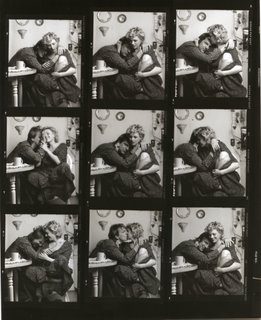 What is there to say? Actually, there's no need to say very much on cover notes beyond the names of the songs and the players. (I like to see the dates of the recordings also, myself.). But I notice a lot of jazz albums these days (some of my own included) whose notes go pretty far afield, with hardly a mention about what's inside (sometimes no mention at all). What is there to say? Actually, there's no need to say very much on cover notes beyond the names of the songs and the players. (I like to see the dates of the recordings also, myself.). But I notice a lot of jazz albums these days (some of my own included) whose notes go pretty far afield, with hardly a mention about what's inside (sometimes no mention at all).
I will now go far afield.
Jazz music is fun to me. All music can be fun for that matter, but what I mean is we usually have a hell of a good time playing and listening to each other.
But some of the people who do the most talking about jazz (that may even be the basic problem, right there!) don't seem to get any real fun out of listening to it. It seems to me that all the super-intellectualizing on the technics of jazz and the lack of response to the emotion and meaning of jazz is spoiling the fun for listeners and players alike.
So if the critics haven't got everyone scared with a lot of high-flown technical talk and Jack Kerouac hasn't got everyone impressed with the beauties of numbness and hipness for hipness' sake, maybe we could launch a little enthusiasm and restore fun to its rightful place in jazz.
Now, inside this jacket is a record (or should be!) into which we (meaning the Quartet and the people from Columbia) put a great deal of work to make as good an album as we could. And at the risk of sounding indecent, I'd like to say we all had a lot of fun making it.

Now we just hope you have a share in our fun.
Monday, March 23, 2009
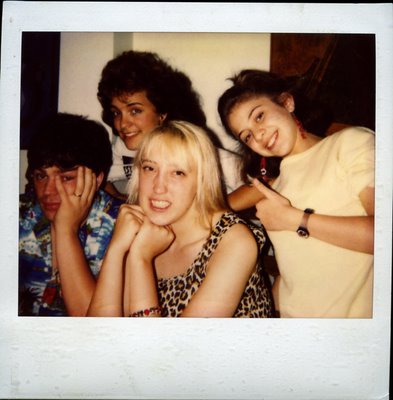 Polaroids have been on my mind of late. I wrote about Polaroids here and today I had one more reason to think about them. I was telling Rebecca about my excitement of being able to see Art Bergmann perform (in spite of the fact that he has not played his guitar in over 5 years because of terrible arthritis) this Thursday at Richards on Richards. I further explained to her that I had photographed Art many times through the years (at least 20) and that Art was going to pose for me in my studio on Wednesday. I brought Rebecca to the computer and I played Hawaii. This version of the quintessential (and in my opinion the only Vancouver song) tune by Art Bergmann and performed by his band of 1979, The Young Canadians, is so much fun in so many ways. One of them has a direct connection to Rebecca. The beautiful go-go girl with the lovely legs in the video, is Modernettes' bassist Mary Jo Kopechne. To the left of my computer is a book case. From it I retrieved a Polaroid taken so many years ago. In it from left to right is Buck Cherry (John Armstrong) my daughter Ale, Mary Jo and to the right Rebecca's mother, Hilary who is my younger daughter. I had invited Buck and Mary for dinner one day and I took this Polaroid. Art Bergmann's concertKiller version of Hawaii
Hope And Glory On An Almost Perfect Sunday
Sunday, March 22, 2009

While watching, with my granddaughter Rebecca, John Boorman’s 1987 film Hope and Glory, Sarah Miles as Grace, and her three sisters Faith, Hope and Charity play a string quartet some thoughts on my early life in Buenos Aires came to mind. They entertain themselves and their family during the waning days of the London Blitz on a house on the Thames. Rebecca said to me, “They had to entertain themselves because they had no TV.”
As a little boy my parents used to take me to visit relatives. I remember one visit in particular because of the smells. We went to visit my father’s older brother Harry and his wife Winnie at their home in Acassuso in the outskirts of Buenos Aires. Uncle Harry drank a lot and he always smelled of whisky and tobacco. It was the Hayward smell. From my vantage point by the kitchen table (I remember really looking up so I must have been 8) I watched Uncle Harry prepare some Colman mustard from scratch. I remember my surprise at watching him put a spoonful of sugar into his mixture. “How odd," I thought. After dinner Auntie Winnie served us tea in beautiful bone china and I noticed her twisted arthritic hands.
These visits were not as frequent as those where my relatives came to our house. This was so because we had a garden. Uncle Tony, his son Wenci and my Tía Sarita would come on Saturdays and Uncle Tony would bring his U-control airplanes that he would fly in the nearby GE Field. One weekend it might be a beautiful Curtiss P-40 with the shark face on the engine cowling, and a beautiful sky blue under body paint with the standard camouflage on the top. On another week it was Focke-Wulf FW 190 but my favourite was a big, black, Stuka Ju87. Uncle Tony once built it with an authentic bent wing instead of the usual U-control straight wing. The Stuka was so un-maneuverable that it soon crashed. Uncle Tony poured the engine fuel over the wreckage and ritually burn it. We would go home for lunch and he would tell us, with a smile on his face, that he would build and even more beautiful Stuka. Uncle Tony also had the habit of dumping his pets (he lived in an apartment) on us. That is how we inherited over the years a Collie, a giant brown poodle, many turtles and assorted cats.
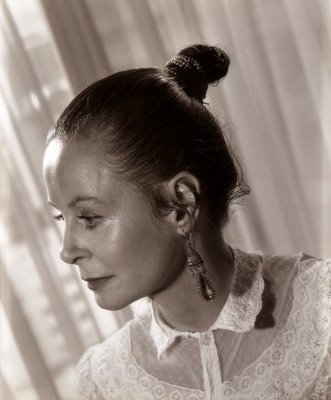
I remember those days fondly as I was growing up. Uncle Tony had taught me that things were things and no matter how valuable they could always be replaced if lost. Somehow Uncle Harry had challenged my idea that salty was salty and sweet was sweet and they could never convivir.
Today was such a day. It was sunny and I was able to garden. In spite of so many dead roses and shrubs I shrugged it off as my Uncle Tony would have. Rebecca arrived for her piano lesson at noon and Lauren accompanied me in the garden as I sprinkled alfalfa meal and Epsom salts on my roses. When Lauren asked me why I told her, “Plants eat just like we do and the Epsom salts will help them eat better. The alfalfa will (and we don’t know exactly why) induce the roses, even the dead ones, perhaps, to send up new growth.”
For lunch we had angel hair pasta the way Rebecca likes it. I chop up half an onion, a put in a cup of frozen peas over the angel hair. Lauren helps to grate the Parmesan. This time we pleased Lauren and instead of having a fresh fruit shake we had ginger ale with grenadine.
After lunch I went to Videomatica to choose a film for the afternoon. I go straight to the British movie section. It is here where I always find something good. I find something that will entertain the children without boring us. I find something with special effects, violence and destruction. Of the latter today’s film had lots of it as it was John Boorman’s Hope and Glory. This is an autobiographical film he wrote, produced and directed. It is a perfect Sunday afternoon movie to watch with one’s grandchildren. We all laughed when the little boy’s father teaches the boy to bowl a googly (In cricket a googly, is a type of delivery bowled by a right-arm leg spin bowler.)
We had not finished the film when Rebecca and Lauren’s parents arrived. I had prepared a pork loin on the barbecue, saffron rice and Rosemary had taken care of the mixed salad. We drank a blender mix of papaya, mango and orange and for dessert we had cherry Jell-O with canned peaches (Lauren’s favourite and Island Farms Chocolate Mint Burst ice-cream (my favourite).
The only thing that marred the perfect day was that I forgot to spoon some sugar into my Colman’s mustard. It was odd to see myself in the moody grandfather of the film played by Ian Bannen and my visiting relatives as the ones in whom my plans for the day will become someday their fond (I hope) memories.
|


























